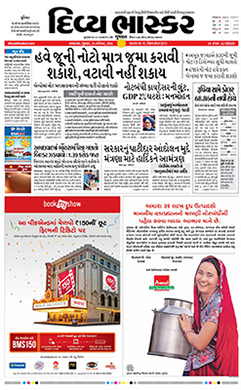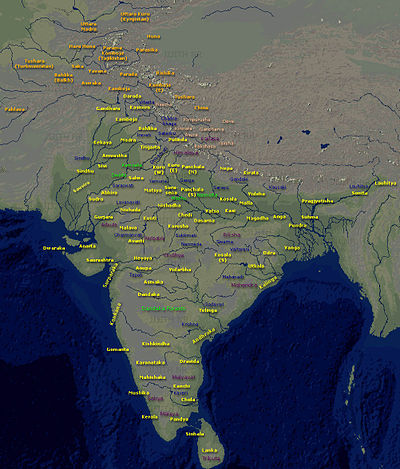
Kathiawar is a peninsula, near the far north of India's west coast, of about 61,000 km2 (23,500 sq mi) bordering the Arabian Sea. It is bounded by the Gulf of Kutch in the northwest and by the Gulf of Khambhat in the east. In the northeast, it is connected to the rest of Gujarat and borders on the low, fertile hinterland of Ahmedabad. It is crossed by two belts of hill country and is drained radially by nine rivers which have little natural flow aside from in monsoon months, thus dams have been built on some of these. Kathiawar ports have been flourishing centres of trade and commerce since at least the 16th century.

Junagadh is the city and headquarters of Junagadh district in the Indian state of Gujarat. Located at the foot of the Girnar hills, 355 kilometres (221 mi) southwest of Ahmedabad and Gandhinagar, it is the seventh largest city in the state. It is dominated by the Chudasama clan of Rajputs since ancient times.

Halar (Haalaar) is a historical region of western India, located by the Gulf of Kutch coast on the northwestern area of Nawanagar, now Jamnagar, in Gujarat State, on Saurashtra peninsula, roughly corresponding to the present Jamnagar District, Devbhumi Dwarka district, Morbi District and Rajkot District.

Divya Bhaskar is a Gujarati newspaper in Gujarat, India, owned by D B Corp Ltd. It is one of the highest circulation Gujarati dailies. With the most local editions in Gujarat, it is published from Ahmedabad, Vadodara, Surat, Rajkot, Jamnagar, Mehsana, Bhuj, Bhavnagar and Junagadh.
Una is a town and a municipality in Gir Somnath district of the Saurashtra region in the state of Gujarat, India.
Saurashtra, Sourashtra, or variants may refer to:

Gujarat is a state located in western India. Its north-western border, which is also the international border, is adjacent to Pakistan. Rajasthan and Madhya Pradesh are the states located in its north and north-east respectively. Maharashtra is to its south. The Arabian Sea forms its western-southern boundary. Dadar and Nagar-Haveli are on its southern border.
Saurashtra Railway came into being in April, 1948 with the amalgamation of state railways like Bhavnagar State Railway, Gondal Railway, Porbandar Railway, Jamnagar & Dwarka Railway, Morvi Railway, Dhrangadhra Railway, Okhamandal State Railway, Junagadh State Railway, Baria State Railway, Rajpipla Railway etc.

The Bhal region is an area of Gujarat, India. It is spread across the political boundaries of the districts of Bhavnagar, Ahmedabad, and Anand. The Bhal region is situated on the deltas of the Sabarmati, Bhogawo, Bhadar, Lilka and other rivers that flow east and southeast off the Kathiawar peninsula into the Gulf of Cambay. The word Bhaal seems to have been derived from the Sanskrit word भाल which means forehead. Such a name is given to this region probably because it is mostly as flat as a forehead with almost entire region's soil without any stones, pebbles or gravel.
The Machhoya are a Gotra of the Ahir found in the Rajkot, Kutch, Junagadh, Dwarka, Amreli, Bhavnagar, Morbi, Jamnagar districts of Gujarat in India.

Saurashtra State, formally known as United State of Kathiawar and later United State of Saurashtra, was a State of India that existed between 1948 and 1956, on Saurashtra alias Kathiawar peninsula, with Rajkot as its capital,
Mavjinjava is a small village near Bagasara in the Amreli district of the Saurashtra region in the state of Gujarat, India. There is a population of around 3,754 people in Mavjinjava. More than 3000 people live outside of Manjinjava in places like Surat, Ahmedabad & Mumbai.

The Viramgam–Okha line is a railway passing through Gujarat State, in western India. Which is branch of Gandhidham–Ahmedabad main line that connects Ahmedabad with major cities like Rajkot, Jamnagar, Surendranagar, Dwarka and also produces branch line for Bhavnagar, Junagadh, Morbi, Veraval and Porbander. Recently it has been fully electrified and there is double line section up to Rajkot.
The Chudasama dynasty, a Samma branch, ruled parts of the present-day Saurashtra region of Gujarat state in India between the 9th and 15th centuries. Their capital was based in Junagadh and Vamanasthali.
The Chitravav (Divani) is a village in Rajkot Taluka of Rajkot district, Gujarat, India and former petty Rajput princely state.
Bhoika is a village and former Rajput princely state in Limbadi Taluka of Surendranagar district, on Saurashtra in Gujarat, India.

The early history of the Chudasama dynasty in Saurashtra is largely lost. Bardic legends vary significantly in names, sequence, and numbers, rendering them unreliable as historical sources. Mandalika Kavya, a Sanskrit poem by Gangadhara, provides some information on the dynasty, though it holds limited historical accuracy. Certain inscriptions from the period offer early genealogical details, but these also vary in their order of succession. Historians like Ranchhodji Diwan, A. K. Forbes, James Burgess, and Gaurishankar Oza have attempted to determine a more consistent genealogy and chronology. Based on dates from inscriptions linked to Chudasama kings and other literary sources, the genealogy and chronology of the dynasty's later period are now relatively established. It is known that they ruled approximately from Vikram Samvat (VS) 900 to VS 1527, or around 875 CE to 1472 CE.
Ra Jayasimha II was a Chudasama king of Saurashtra region of western India who reigned from 1416 CE to 1430 CE. His capital was at Junagadh.
The Gohil dynasty or Gohil or Guhilas of Saurashtra ruled parts of Saurashtra region of present-day Gujarat state of India as subordinates or independents starting 12th century. Their origin is traced to Guhila dynasty of Gujarat and they had migrated to Saurashtra in 12th century. The earliest known inscription of Gohils is found from Mangrol. They later moved to the east coast where they established themselves and the region came to be known as Gohilwar and ruled till the independence of India in 1947. The erstwhile princely states of Bhavnagar, Palitana, Lathi, Vala and Rajpipla belonged to Gohil rulers.

Kathiawar is a peninsula which today forms part of the Indian state of Gujarat. The peninsula covers an area of 23,345 sq. miles and in 1901 had a population of 2,645,805.














